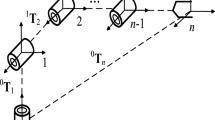Abstract
Robot manipulators are widely used in various areas of industrial factory automation. However, their base positioning is still achieved through trial-and-error methods based on the intuition and expertise of the engineer, even with the use of off-line programming software. Most previous studies do not provide on-line or on-site solutions suitable for practical applications because the nonlinearity and derivative complexity of the robot kinematics result in heavy computational burden and lengthy processing times. In this paper, we suggest a convex programming approach that uses time-efficient and reliable methods to solve the optimization problem in order to determine the base position of a six-degrees-of-freedom articulated robot with a spherical wrist. The proposed method uses convex optimization to accurately check the reachability of the given task without solving the inverse kinematics and to determine the feasible base position to satisfy singularity avoidance and spatial limitations. The feasibility of the proposed method is evaluated through various simulations, and the results show that not only the feasible base position but also the range of allowable base locations as an ellipsoidal volume can be provided within a few minutes without high computing performance or large resources.
Similar content being viewed by others
References
Pan Z, Polden J, Larkin N, Van Duin S, Norrish J (2010) Recent progress on programming methods for industrial robots. In: 2010 41st international symposium on and 2010 6th german conference on robotics (ROBOTIK) Robotics (ISR), VDE, pp 1-8
Mitsi S, Bouzakis KD, Sagris D, Mansour G (2008) Determination of optimum robot base location considering discrete end-effector positions by means of hybrid genetic algorithm. Robot Comput Integr Manuf 24 (1):50–59
Nektarios A, Aspragathos NA (2010) Optimal location of a general position and orientation end-effector’s path relative to manipulator’s base, considering velocity performance. Robot Comput Integr Manuf 26(2):162–173
Nguyen QC, Kim Y, Kwon H (2017) Optimization of layout and path planning of surgical robotic system. Int J Control Autom Syst 15(1):375–384
Spensieri D, Carlson JS, Bohlin R, Kressin J, Shi J (2016) Optimal robot placement for tasks execution. Procedia CIRP 44:395–400
Kamrani B, Berbyuk V, Wäppling D, Stickelmann U, Feng X (2009) Optimal robot placement using response surface method. Int J Adv Manuf Technol 44(1-2):201–210
Zhang J, Fang X (2013) Response surface method based robotic cells layout optimization in small part assembly. In: 2013 44th international symposium on robotics (ISR), IEEE, pp 1–6
dos Santos RR, Steffen V, Saramago SdFP (2010) Optimal task placement of a serial robot manipulator for manipulability and mechanical power optimization. Intell Inf Manag 2(09):512
Doan NCN, Lin W (2017) Optimal robot placement with consideration of redundancy problem for wrist-partitioned 6r articulated robots. Robot Comput Integr Manuf 48:233–242
Ren S, Xie Y, Yang X, Xu J, Wang G, Chen K (2017) A method for optimizing the base position of mobile painting manipulators. IEEE Trans Autom Sci Eng 14(1):370–375
Yu Q, Wang G, Hua X, Zhang S, Song L, Zhang J, Chen K (2018) Base position optimization for mobile painting robot manipulators with multiple constraints. Robot Comput Integr Manuf 54:56–64
Asokan T, Seet G, Lau M, Low E (2005) Optimum positioning of an underwater intervention robot to maximise workspace manipulability. Mechatronics 15(6):747–766
Zacharias F, Borst C, Hirzinger G (2007) Capturing robot workspace structure: representing robot capabilities. In: IEEE/RSJ international conference on intelligent robots and systems, 2007. IROS 2007. IEEE, pp 3229–3236
Zacharias F, Borst C, Hirzinger G (2009a) Online generation of reachable grasps for dexterous manipulation using a representation of the reachable workspace. In: 2009 international conference on advanced robotics, 2009. ICAR. IEEE, pp 1-8
Zacharias F, Sepp W, Borst C, Hirzinger G (2009b) Using a model of the reachable workspace to position mobile manipulators for 3-d trajectories. In: 9th IEEE-RAS international conference on humanoid robots, 2009. Humanoids 2009. IEEE, pp 55–61
Porges O, Lampariello R, Artigas J, Wedler A, Borst C, Roa MA (2015) Reachability and dexterity: Analysis and applications for space robotics. In: Proceedings of the workshop on advanced space technologies for robotics and automation (ASTRA
Vahrenkamp N, Asfour T, Dillmann R (2013) Robot placement based on reachability inversion. In: 2013 IEEE international conference on robotics and automation (ICRA). IEEE, pp 1970–1975
Dong J, Trinkle JC (2015) Orientation-based reachability map for robot base placement. In: 2015 IEEE/RSJ international conference on intelligent robots and systems (IROS). IEEE, pp 1488–1493
Makhal A, Goins AK (2018) Reuleaux: Robot base placement by reachability analysis. In: 2018 2nd IEEE international conference on robotic computing (IRC). IEEE, pp 137–142
Barber CB, Dobkin DP, Huhdanpaa H (1996) The quickhull algorithm for convex hulls. ACM Trans Math Software (TOMS) 22(4):469–483
Boyd S, Vandenberghe L (2004) Convex optimization. Cambridge university press, Cambridge
Spong MW, Vidyasagar M (2008) Robot dynamics and control. Wiley, New Year
Yoshikawa T (1985) Manipulability of robotic mechanisms. Int J Robot Res 4(2):3–9
Grant M, Boyd S (2014) CVX: Matlab software for disciplined convex programming, version 2.1. http://cvxr.com/cvx
Author information
Authors and Affiliations
Corresponding author
Additional information
Publisher’s note
Springer Nature remains neutral with regard to jurisdictional claims in published maps and institutional affiliations.
Appendix
Appendix
Details regarding the desired trajectories of four cases shown in Fig. 13 for the computer simulations are presented below. (X,Y,Z) and (Rx, Ry, Rz), which represents the Euler ZYX angle, denote the desired position and orientation of the end-effector with respect to the global frame, respectively.
1.1 Case 1: Simple line motion
1.2 Case 2: Combination of line motions
1.3 Case 3: Combination of line and arc motions
1.4 Case 4: Typical picking and placing motion
Rights and permissions
About this article
Cite this article
Son, SW., Kwon, DS. A convex programming approach to the base placement of a 6-DOF articulated robot with a spherical wrist. Int J Adv Manuf Technol 102, 3135–3150 (2019). https://doi.org/10.1007/s00170-019-03391-0
Received:
Accepted:
Published:
Issue Date:
DOI: https://doi.org/10.1007/s00170-019-03391-0




